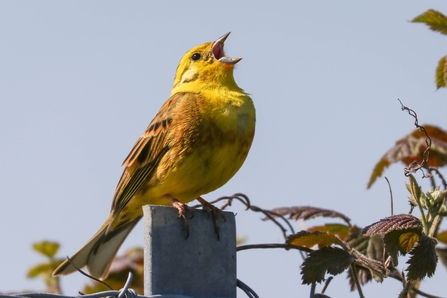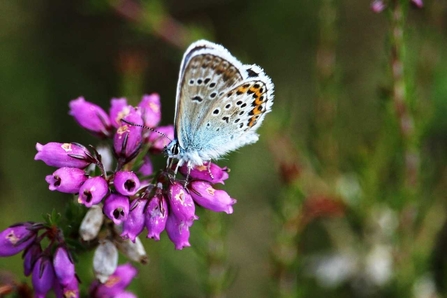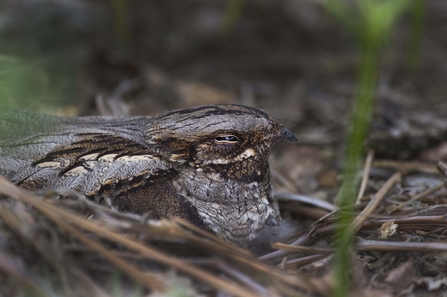At the time of writing ‘flaming June’ is living up to its name, with the hottest day of the year so far recorded on the 21st. The long warm days and evenings of June finds Norfolk’s wildlife really swinging into action. The fringes of lanes and by-ways are ablaze with ox-eye daisy and swaying cow parsley. Orchids are raising their ornate heads on our heathland and fenland reserves and, although birdsong is on the wane, the constant cuckoo and repetitive chiffchaff are still a feature of June. If you are lucky you may still have a yellowhammer singing from a hedge-top on one of your local walks. Its puffed-out sulphur-yellow breast, and demand for a ‘little bit of bread, but no cheese’ is one of those beautiful sights and sounds of summer. Sadly, it is becoming increasingly difficult to find one, even if you did want to oblige it with breadcrumbs. After the spring emergence, it tends to go a little quiet in regards to butterflies, but as we run into July a sudden flurry of different species and increased numbers occurs. Meadow browns, ringlets and gatekeepers appear wherever a cover of wildflowers grow. The bramble patches in dappled woodland glades play host to skipper and comma butterflies, and if fortunate a white admiral too.
June on our reserves
Meadow brown butterfly on field scabious (credit: NWT)

Credit: Terry Postle
Conservation Manager Steve Collin has visited NWT Buxton Heath many, many times. But this month’s visit coincided with the 21st anniversary of the restoration of the southside of Buxton Heath; a task that meant wrestling it back from decades of conifer plantation use. The establishment and recovery of the former heathland flora and fauna has been slow but steady, although the hard work over many years is really starting to pay off. It is one of the few sites in East Anglia were silver-studded blue butterflies are found, and they are doing astonishingly well. Steve reported that, ‘the re-establishment of silver-studded blues has been tentative at best, but the last few years, and this one especially, has seen bumper numbers’. This is particularly promising as it is still early in the species’ flight season, they are normally ‘on the wing’ from mid-June through to mid-August.
With an array of heathland species, including several kinds of orchid, sundew and keeled skimmer dragonflies, the restoration work is proving to be a massive conservation success story. Steve stated that, ‘this achievement is thanks to all the staff, past and present, that have contributed, particularly the Woods & Heaths team and the Grazing team’. Ponies and cattle carry out controlled and targeted grazing on the site, and this is vitally important for keeping heathland habitats in good condition.

Credit: Peter Dent
Some unusual birds continued to appear across several of NWT’s reserves, with a marsh warbler spending the best part of June at NWT Cley and Salthouse Marshes reserve. Formerly a regular breeding bird in the UK, the marsh warbler rarely stays to raise young in Britain now. Looking like a ‘little brown job’ - as many warblers do - what sets the marsh warbler apart is its wonderful mimicry. Its song can carry all sorts of notes and phrases from an array of birds, even African species, with these being picked up in its sub-Saharan winter quarters. At NWT Hickling Broad and Marshes, a pectoral sandpiper spent several days and was later joined by a purple heron. Climate displacement from frequently drought-hit Spain will probably see this bird becoming an increasingly common sight in Norfolk. As the month slips into July, the return migration of many wader species will be picking up, with wood and green sandpipers stopping off to ‘re-fuel’ around sun-shrunk pools.
Credit: Julian Thomas
What to look out for in July
July is the month many of our butterfly species are on the wing, and it is worth keeping an eye out for one of the less familiar migratory species, such as the painted lady or clouded yellow. An evening’s walk on a common or heathland may find glow-worms lighting the way along your path. The insect is actually the larval stage of a beetle, and rather surprisingly the glow-worms feed on snails! Fen and Broadland dyke edges are bursting with colour, as purple loosestrife, meadowsweet, hemp agrimony and yellow loosestrife break into bloom. These are great places to search for both familiar and unusual bees, beetles and other pollenating insects.
Take action
Why not visit NWT’s Buxton Heath and see for yourself the fantastic work that has been carried out there. July is a great time to spot the silver-studded blue, and many other butterfly species. If you stay on into the dusk, you could catch sight of a nightjar. This strange and elusive bird of the twilight can often be seen hawking for moths on the heath.

©David Tipling/2020VISION

